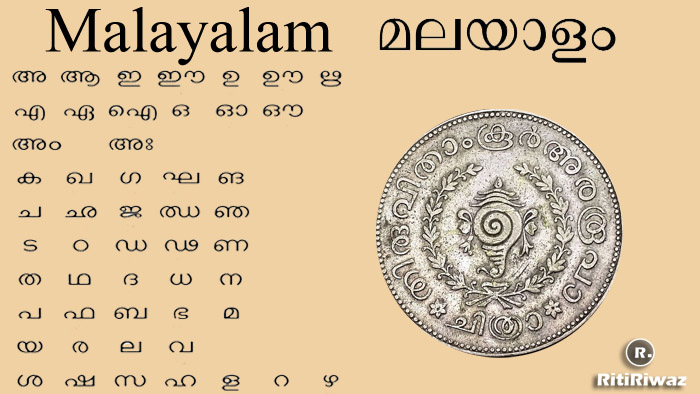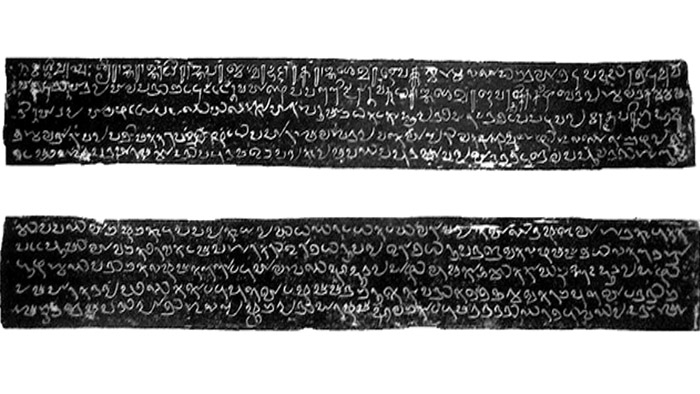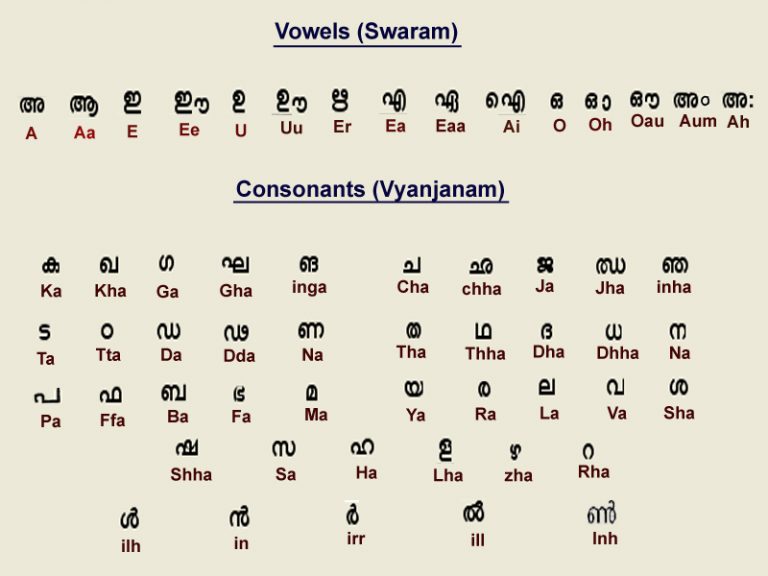Malayalam Language

Malayalam is the native language spoken by the Malayalees in the Indian state of Kerala and the union territories of Lakshadweep and Puducherry. Malayalam is a language of the Dravidian family and is very similar to Tamil as they both belong to the same family. It might be regarded as Malayalam being the ancient dialect of Tamil. But Malayalam is more independent and closer to Sanskrit than the Tamil language. The speaker of Malayalam is called Malayali or Malabari. Malayalam is spoken by 38 million people worldwide. Due to Malayali expatriates in the Persian Gulf, the language is also widely spoken in Gulf countries.
The word Malayalam originally meant mountainous country (mala-mountain + aLam-place). Tamil Nadu is its neighbor on the south and east and Karnataka on the north and east.
History of Malayalam

Scholars believe that the common ancestor of Tamil and Malayalam split in the 9th century AD, giving rise to Malayalam as a language distinct from Tamil. Tamil subsequently influenced the early development of Malayalam because it was the language of scholarship and administration. It developed into the current form mainly by the influence of the poet Thunchaththu Ezhuthachan in the 16th century. The oldest documents written purely in Malayalam and still surviving are the Vazhappalli Copper plates from 832 and Tharisapalli Copper plates from 849.
The first inscription in Malayalam goes back to the 9th-10th centuries AD. Literature, consisting mostly of translated Hindu epics and lyric poetry, dates from the 13th century. Malayalam prose of different periods shows varying degrees of influence of other languages such as Tamil, Sanskrit, Hindi, Urdu, Arabic, Persian, Portuguese, Dutch, French, and English. The modern script of Malayalam Language evolved from the ‘Grandha Script’ which came into existence by the 16th century, the Modern Malayalam literature is rich in poetry, fiction, drama, and biography. Malayalam started to develop as a separate language from the 13th century onwards. It’s the major language of Kerala and Lakshadweep.
Languages and Dialects
Tamil and Malayalam differed as dialects of the same member of the Dravidian family. The chief difference between Malayalam and the other Dravidian tongues is that in the former, the verb has gradually got itself divested of all distinctions as to gender, number, and person.
As in the case of all other languages, there is some difference between the colloquial languages and the written dialect in Malayalam also. Though there is a difference in the dialects spoken by the various sections and classes of the society, the fundamental unity of the Malayalam languages is not affected in any way. The dialects spoken by the more primitive of the hill tribes differ considerably from Malayalam, but they hardly deserve to be regarded as separate languages.
Malayalam is a language with fewer dialects than other Indian languages. Dialects usually arise due to social hierarchies. Each dialect is practiced in all three forms: reading, writing, and speaking. At times, the slang phrases differ so drastically from each other that speakers of different dialects find it difficult to understand another person with another dialect. The dialects of Malayalam are distinguishable at regional and social levels mainly there are at least five main regional dialects of Malayalam and a number of communal dialects.
The salient features of many varieties of tribal speech (e.g., the speech of Muthuvans, Malayarayas, Malai Ulladas, Kanikkars, Kadars, Paliyars, Kurumas, and Vedas) and those of the various dialects Namboothiris, Nairs, Ezhavas, Syrian Christians (Nasrani), Muslims, fishermen and many of the occupational terms common to different sections of Malayalees have been identified.
The 13 dialects Malayalam can be divided into are Malabar, Nagari-Malayalam, South Kerala, Central Kerala, North Kerala, Kayavar, Namboodiri, Nair, Moplah (Mapilla), Pulaya, Nasrani, and Kasargod. The community dialects are Namboodiri, Nair, Moplah (Mapilla), Pulaya, and Nasrani. Whereas both the Namboothiri and Nair dialects have a common nature, the Mapilla dialect is among the most divergent of dialects, differing considerably from literary Malayalam. Jeseri is a dialect of Malayalam spoken mainly in the Union territory of Lakshadweep which is nearer to Kerala.
Malayalam Alphabets

The language has 54 alphabets. There are 37 consonants and 16 vowels in the script. Many words have been borrowed from Sanskrit. Even if the land of Kerala is small and the number of people speaking Malayalam is limited, the growth of literature in Malayalam finds no barriers.
Dictionaries sort the 16 independent vowels before the 36 consonants. The ordering of the vowels resembles Unicode ordering, but is not identical: അ ആ ഇ ഈ ഉ ഊ ഋ ൠ ഌ ൡ എ ഏ ഐ ഒ ഓ ഔ
Also, the ordering of the 36 consonant symbols resembles Unicode ordering, but is not identical:
ക ഖ ഗ ഘ ങ ച ഛ ജ ഝ ഞ ട ഠ ഡ ഢ ണ ത ഥ ദ ധ ന പ ഫ ബ ഭ മ യ ര ല വ ശ ഷ സ ഹ ള ഴ റ
The Malayalam language has a large vocabulary, with around 90,000 words listed in the dictionary. It consists of the number of words borrowed from Sanskrit and Proto-Dravidian language. The arrival of Europeans further enriched the Malayalam vocabulary with large absorbing numerous words and idioms from English, Portuguese, and Dutch, etc. You can find people speaking Malayalam in all corners of the world. This is due to the interest of people in Kerala to migrate to other countries in search of a job.
Malayalam literature
The earliest known extant literary work in Malayalam is Ramacharitam, an epic poem written by Cheeraman in the late 13th or early 13th century. In the subsequent centuries, besides a popular pattu (“song”) literature, the manipravalam poetry also flourished. Manipravalam (translates”ruby coral”) style mainly consisted of poetry in an admixture of Malayalam and Sanskrit. Then came works such as champus and sandeshakavyas in which prose and poetry were interspersed. Later, poets like Cherusseriintroduced poems on devotional themes. There were also other important works, similar to manipravalam, in Arabi Malayalam like Muhyadheen Mala. Ezhuthachan, a strong proponent of the Bhakti movement, is known as the father of Malayalam. His poems are classified under the genre of kilippattu.
The modern Malayalam literature came with the rise of the famous Modern Triumvirate consisting of Kumaran Asan, Ulloor S. Parameswara Iyer, and Vallathol Narayana Menon. The modern Malayalam poetry records the encounter with problems of social, political, and economic life and is regarded as towards political radicalism.






